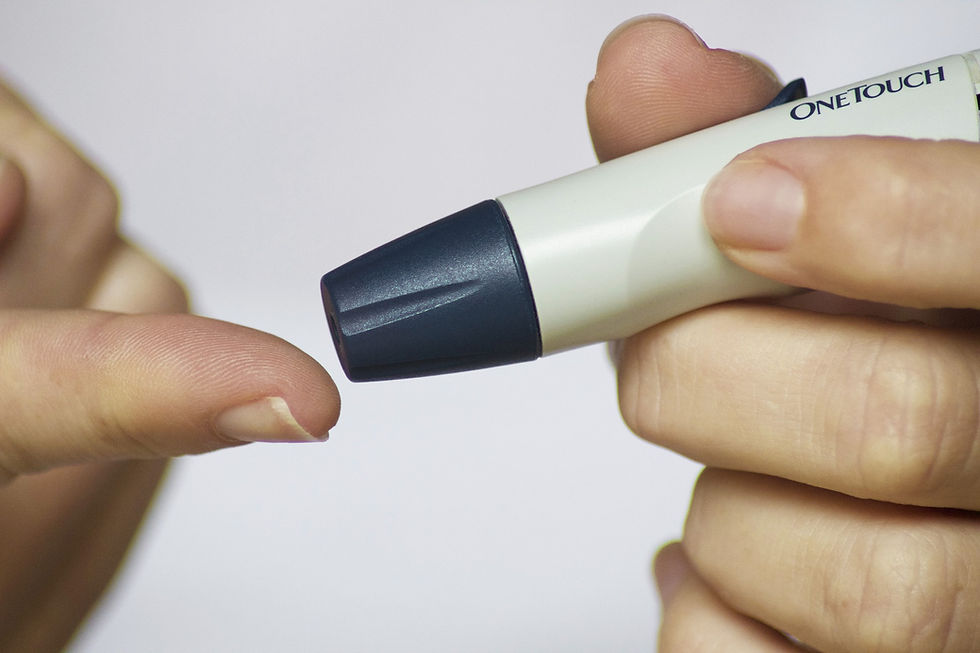Explaining Diabetes - Awareness Month
- Matthias Ferrieres
- Feb 3, 2022
- 3 min read
Diabetes is a chronic (long-lasting) health condition that affects how your body turns food into energy. Most of the food you eat is broken down into sugar (also called glucose) and released into your bloodstream. When your blood sugar goes up, it signals your pancreas to release insulin.

There are two types of diabetes:
diabetes of type 1 is a genetic disorder that often shows up early in life, and type 2 is largely diet-related and develops over time. If you have type 1 diabetes, your immune system is attacking and destroying the insulin-producing cells in your pancreas.
There is also Prediabetes.
Prediabetes occurs when your blood sugar levels are higher than normal, but not high enough to be classified as diabetes.
Prediabetes is often the precursor of diabetes unless appropriate measures are taken to prevent progression.
Gestational diabetes occurs during pregnancy but may resolve after the baby is delivered.
What are the 5 signs of diabetes?
Urinate (pee) a lot, often at night.
Are very thirsty.
Lose weight without trying.
Are very hungry.
Have blurry vision.
Have numb or tingling hands or feet.
Feel very tired.
Have very dry skin.

What is the main cause of diabetes?
Although not everyone with type 2 diabetes is overweight, obesity and an inactive lifestyle are two of the most common causes of type 2 diabetes, yet we can point out few others:
Family history. Your risk increases if a parent or sibling has type 2 diabetes.
Race or ethnicity. Although it's unclear why, certain people — including Black, Hispanic, American Indian and Asian American people — are at higher risk.
Age. Your risk increases as you get older. This may be because you tend to exercise less, lose muscle mass and gain weight as you age. But type 2 diabetes is also increasing among children, adolescents and younger adults.
Gestational diabetes. If you developed gestational diabetes when you were pregnant, your risk of developing prediabetes and type 2 diabetes increases. If you gave birth to a baby weighing more than 9 pounds (4 kilograms), you're also at risk of type 2 diabetes.
Polycystic ovary syndrome. For women, having polycystic ovary syndrome — a common condition characterized by irregular menstrual periods, excess hair growth and obesity — increases the risk of diabetes.
High blood pressure. Having blood pressure over 140/90 millimeters of mercury (mm Hg) is linked to an increased risk of type 2 diabetes.
Abnormal cholesterol and triglyceride levels. If you have low levels of high-density lipoprotein (HDL), or "good," cholesterol, your risk of type 2 diabetes is higher. Triglycerides are another type of fat carried in the blood. People with high levels of triglycerides have an increased risk of type 2 diabetes. Your doctor can let you know what your cholesterol and triglyceride levels are.
Can diabetes be cured?
There is no known cure for type 2 diabetes. But it can be controlled. And in some cases, it goes into remission. For some people, a diabetes-healthy lifestyle is enough to control their blood sugar levels.

When to see a doctor?
If you suspect you or your child may have diabetes. If you notice any possible diabetes symptoms, contact your doctor. The earlier the condition is diagnosed, the sooner treatment can begin.
If you've already been diagnosed with diabetesdiabetes. After you receive your diagnosis, you'll need close medical follow-up until your blood sugar levels stabilize.
Should you have any concerns or believe you should consult, contact our Wellnex Concierge to assist you in finding the right doctor!




Comments